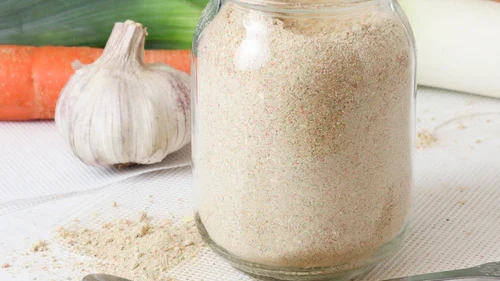Your Cart is Empty

How to make vegetable stock powder in a food dehydrator
Barb Hodgens
Barb Hodgens loves to cook with alternative, healthy whole food ingredients, with a focus on gut health. Barb has overcome her own gut health issues through healthy eating. Share your ideas, comments and photos at the end of this post :)

ADDITIVE FREE, VEGGIE FLAVOUR TO THE RESCUE.
We love to cook from scratch with real ingredients, but we also love a good shortcut to a quick tasty meal. Commercial vegetable stock powder and veggie salt blends are a common pantry ingredient to help time poor home cooks, but the ingredients list is often questionable. Making a batch of homemade veggie stock powder is a far healthier solution and it’s so easy to do. This blend is 100% natural, and made purely with fresh, vegetables, herbs and good quality salt. All you need to do is chop vegetables and all you need is the Breeze food dehydrator and a high-speed blender. With very little effort you'll be able to enjoy a super tasty, stock powder that is nutritionally far superior to anything you can buy.
We love the simple combination of vegetables in the basic blend because it works well as a base with all cuisines, but feel free to include other herbs and vegetables to come up with your own unique blend. You could add capsicum, tomato, basil or sage for an Italian style stock, or, ginger, lemon grass and chilli for an Asian flavour. Experiment, the possibilities are endless. This flavourful homemade stock powder is so handy and versatile you’ll wonder why you didn’t make it sooner!

HOW TO USE HOMEMADE VEGGIE STOCK POWER
Your homemade stock powder is ready to use in any recipe calling for stock or broth, such as soups, stews, stir-fry, risotto, etc, but it also makes a great seasoning, so add it to burgers, crumbing ingredients or sprinkle a bit on salads or roast vegetables. Any dish that needs an extra dose of flavour can be enhanced with homemade vegetable stock powder.
As a guide, 1 teaspoon of homemade veggie stock powder makes 1 cup of liquid stock.

TIPS FOR MAKING VEGGIE STOCK POWDER
- Try to cut each vegetable to the same thickness so they dehydrate in approximately the same time.
- Dehydration shrinks vegetables to a fraction of the size. We recommend silicon mesh liners to prevent your vegetables falling through the trays
- Do not pile the vegetable pieces too thick. The dehydrator must have good air flow.
- Some vegetables will naturally take longer than others. To avoid over-drying some vegetables, do not mix the vegetables on the dehydrator trays. If there are not enough trays for each vegetable, combine the ingredients you feel have a similar moisture content.
- When dried, each vegetable will have a different texture. Some become rubbery and flexible and some become more brittle. It all depends on their fibre content. The most important thing is you dehydrate your veggies until there is no moisture left in them.
- Check on the trays after 12 hours. Remove the trays of vegetables that are dehydrated and leave the vegetables with more moisture for another few hours. I found the carrots, turnips and garlic took the longest to dehydrate.



How to make vegetable stock powder in a food dehydrator
Luvele
Rated 5.0 stars by 1 users
We love to cook from scratch with real ingredients, but we also love a good shortcut to a quick tasty meal. Commercial vegetable stock powder and veggie salt blends are a common pantry ingredient to help time poor home cooks, but the ingredients list is often questionable.
Ingredients
- 2 large carrots
- 6 celery ribs
- 1 large leek
- 2 onions
- 8-10 mushrooms
- 8 garlic cloves
- 2 tablespoons of salt
- 2-3 tomatoes
- 1 red capsicum
- 1 thumb of fresh ginger root
- 1 thumb of fresh turmeric root
- Handful of fresh parsley with stems attached
- 2-4 twigs of fresh thyme
- 1-2 twigs of fresh rosemary
- 8 fresh sage leaves
- Handful of fresh basil leaves
Base recipe
Optional extras
Directions
- Wash and peel the veggies then slice into small uniform pieces.
Arrange the veggies on dehydrator trays lined with silicon mesh liners. See the tips above.
Set the temperature to 75 degrees C and the timer 8-10 hours.
Once all your veggies are dried, allow them to cool on the trays and adjust to room temperature for 1-2 hours.
- Tip the dehydrated vegetables into a large bowl or directly into the Vibe blender jug.
Add the salt.
Press the 'pulse' function several times. Lift the jug from the base and give the jug a shake. Return the jug and pulse until the dried vegetables are reduced to a fine powder
- Pour the vegetable powder into a glass jar and seal with a lid.
Store in the pantry, away from direct sunlight or moisture and use within 3 months.
You might also like to try this dehydrated umami mushroom stock powder.
Recipe Video
PIN THIS RECIPE


How to make vegetable stock powder in a food dehydrator

ADDITIVE FREE, VEGGIE FLAVOUR TO THE RESCUE.
We love to cook from scratch with real ingredients, but we also love a good shortcut to a quick tasty meal. Commercial vegetable stock powder and veggie salt blends are a common pantry ingredient to help time poor home cooks, but the ingredients list is often questionable. Making a batch of homemade veggie stock powder is a far healthier solution and it’s so easy to do. This blend is 100% natural, and made purely with fresh, vegetables, herbs and good quality salt. All you need to do is chop vegetables and all you need is the Breeze food dehydrator and a high-speed blender. With very little effort you'll be able to enjoy a super tasty, stock powder that is nutritionally far superior to anything you can buy.
We love the simple combination of vegetables in the basic blend because it works well as a base with all cuisines, but feel free to include other herbs and vegetables to come up with your own unique blend. You could add capsicum, tomato, basil or sage for an Italian style stock, or, ginger, lemon grass and chilli for an Asian flavour. Experiment, the possibilities are endless. This flavourful homemade stock powder is so handy and versatile you’ll wonder why you didn’t make it sooner!

HOW TO USE HOMEMADE VEGGIE STOCK POWER
Your homemade stock powder is ready to use in any recipe calling for stock or broth, such as soups, stews, stir-fry, risotto, etc, but it also makes a great seasoning, so add it to burgers, crumbing ingredients or sprinkle a bit on salads or roast vegetables. Any dish that needs an extra dose of flavour can be enhanced with homemade vegetable stock powder.
As a guide, 1 teaspoon of homemade veggie stock powder makes 1 cup of liquid stock.

TIPS FOR MAKING VEGGIE STOCK POWDER
- Try to cut each vegetable to the same thickness so they dehydrate in approximately the same time.
- Dehydration shrinks vegetables to a fraction of the size. We recommend silicon mesh liners to prevent your vegetables falling through the trays
- Do not pile the vegetable pieces too thick. The dehydrator must have good air flow.
- Some vegetables will naturally take longer than others. To avoid over-drying some vegetables, do not mix the vegetables on the dehydrator trays. If there are not enough trays for each vegetable, combine the ingredients you feel have a similar moisture content.
- When dried, each vegetable will have a different texture. Some become rubbery and flexible and some become more brittle. It all depends on their fibre content. The most important thing is you dehydrate your veggies until there is no moisture left in them.
- Check on the trays after 12 hours. Remove the trays of vegetables that are dehydrated and leave the vegetables with more moisture for another few hours. I found the carrots, turnips and garlic took the longest to dehydrate.


PIN THIS RECIPE


Subscribe
Sign up to get weekly healthy recipes & information on new product releases.


